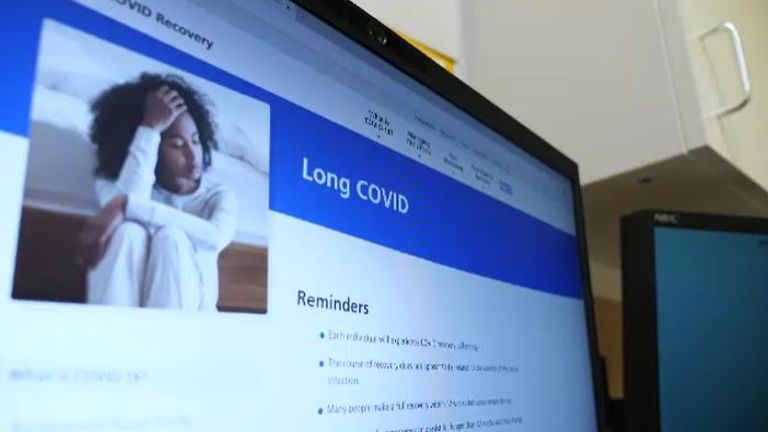Three types of long COVID each with different symptoms, researchers say | UK News
There appear to be three different types of long COVID, each with their own symptoms, researchers have discovered.
One group experiences neurological symptoms including fatigue, brain fog and headache, which most often affect those who contracted the virus when the Alpha and Delta variants were most prevalent, according to experts at King’s College London.
A second group suffers from respiratory issues, including chest pain and severe shortness of breath, which could point to lung damage.
These symptoms were common among those infected during the first wave of the pandemic.
The final group is grappling with a diverse range of symptoms including heart palpitations, muscle ache and pain, and changes in skin and hair.
The three sets of symptoms were seen in all variants, researchers added.
Two million people in the UK are estimated to be suffering from long COVID, the Office for National Statistics (ONS) reported in June, based on self-reports from a representative sample.
Of that two million, 1.4 million said they first had coronavirus, or suspected they had the illness, at least 12 weeks previously, while 826,000 first had it at least a year earlier.
Another 376,000 said they first had COVID-19 at least two years previously.
To draw their conclusions, researchers studied 1,459 people living with long COVID who were taking part in the Zoe Health study and are still dealing with symptoms at least 12 weeks after infection.
Dr Claire Steves, clinical lead author from King’s College London, said: “These data show clearly that post-COVID syndrome is not just one condition, but appears to have at several subtypes.
“Understanding the root causes of these subtypes may help in finding treatment strategies.
“Moreover, these data emphasise the need for long COVID services to incorporate a personalised approach sensitive to the issues of each individual.”
Subscribe to the Daily on Apple Podcasts, Google Podcasts, Spotify, Spreaker
Dr Liane Canas, another author of the study, added: “These insights could aid in the development of personalised diagnosis and treatment for these individuals.”
According to the ONS, rates of long COVID are highest among women, those aged 35 to 69 years, people living in more deprived areas, those working in social care, teaching and education or health care, and those with other health conditions or disabilities.
Read more:
Millions could suffer from long-term smell or taste problems after COVID infection, study says
People living in poverty more likely to get long COVID, study suggests
Fatigue is the most common symptom – experienced by 55% of those with self-reported long COVID – followed by 32% with shortness of breath, 23% with a cough and 23% with muscle ache.
A recent study by the University of Birmingham said symptoms also include amnesia, bowel incontinence, erectile dysfunction and hallucinations.
Read More: Three types of long COVID each with different symptoms, researchers say | UK News


